Stakeholders are the individuals who have a stake or an interest in a project. They all want to achieve certain outcomes from a project. The success of the project depends highly on the successful fulfillment of stakeholder requirements or expectations from the project. However, the biggest challenge is that the expectations of stakeholders vary from one stakeholder to another. This results in the competition of influence and the conflicting priorities in the project because it is highly unlikely to fulfill all the requirements of all the stakeholders in a project due to limited resources and time.
Stakeholder management is the process of identifying, analysing, and managing the project stakeholders, their requirements, and their influences in a project to ensure the interests of all the stakeholders are addressed for the project’s success. It is the role of a project manager to create a stakeholder management plan to identify and manage all the stakeholders of a project and make sure their requirements are fulfilled in a project while ensuring the project is completed within budget and time. It is because if a project is not able to complete within the constraints of budget and time, it is still a failed project, despite fulfilling the stakeholders’ interests. A manager has to strike a balance between stakeholders’ expectations and completing projects within defined constraints to deliver the optimal value for project stakeholders and project success.
In this post, we will look at the importance of stakeholder management and steps to create a stakeholder management plan.
What is stakeholder management?
Stakeholder management is the process of identifying project stakeholders, understanding their requirements, interests, and expectations, prioritizing their requirements based on the importance and impact on the project, and taking actions to implement and manage requirements in the project to fulfill stakeholders’ expectations from the project.
Stakeholder management helps you prepare a roadmap to effectively identify and engage the right stakeholders. It includes building organized channels for communication with stakeholders and realistically managing their expectations. This will help you build quality relationships with your stakeholders and manage the interest and the influence of the stakeholders in the project.
Why is stakeholder management important?
Stakeholder management is important to ensure that the project meets the expectations of the stakeholders. Here is how it helps:
1. Ensure project success
Stakeholders play a key role in shaping the success of the project. When your stakeholders are aware of the timely progress and updates in the project, the chances of major roadblocks and rework are lowered.
Further, with structured stakeholder management in project management, the overall result from the project satisfies the requirements and expectations of all the entities. This ensures completing the project on time and with the expected quality. By involving stakeholders in different stages of the project, you can effectively minimize the chances of project failure.
2. Bring in expertise
Stakeholder management helps you bring added expertise to your projects. Stakeholders have vast knowledge in comparison to your project managers. This ‘extra’ knowledge will provide you with the necessary direction for completing your project.
3. Lower the risk
With effective stakeholder management, you will have to face lower risks. This is because you can involve expert opinions in every stage of the project progression. When you have an effective plan for involving your stakeholders, you can mitigate concerns and issues with ease. By solving such issues on time, you can ensure the successful and timely completion of the project.
4. Build stronger relationships and enhanced engagement
Stakeholders tend to participate in every minute detail of the project progress. This is where you need effective stakeholder management to streamline their participation. You need to incorporate an effective channel for seamless engagement and building strong relationships. This helps you with the smooth progression of the project.
5. Lower the overhead cost
Stakeholders fill up the vacancies and the shortcomings in the project progression. They are aware of the nitty-gritty details of the project methodology. Stakeholders fill the void by providing both knowledge and resources necessary for the project at that particular time. This ensures that you can save on the overhead cost of resources and knowledge.
What is a stakeholder management plan?
Stakeholder management plan refers to the formal documents that contain the details of various stakeholders and the role they play in the project. This plan defines and categorizes different stakeholders based on their involvement in the project.
A stakeholder management plan should generally be created at the start of the project. This helps in keeping all stakeholder expectations transparent and aligning the overall performance of the involved entities.
It is important to note the differences between a stakeholder management plan and a project management plan. A project management plan includes everything from project scope, project baseline, project deliverables, project resources, and project processes to execute, monitor, control, and deliver the project. Whereas a stakeholder management plan focuses on the management of the stakeholders only and is a part of the project plan.
Before getting into the detailed steps of creating a stakeholder management plan, let us understand the key components of the plan.
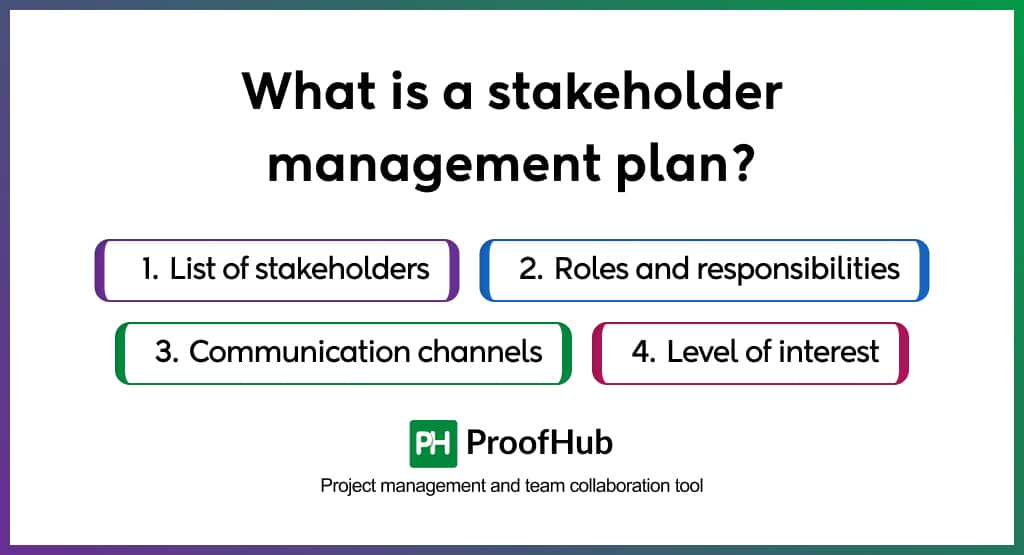
1. List of stakeholders
A quick rundown of the various stakeholders in a project.
- Product manager
- Project managers
- Front-end designers
- Back-end designers
- Marketers
- Directors
- Sponsors
- Investors
These are the major categories of stakeholders, although there can be more or fewer stakeholders as per the project.
2. Roles and responsibilities
Once you identify the stakeholders involved in a particular project, you need to define the roles and responsibilities of each stakeholder precisely. When you define the specific roles of each stakeholder, it becomes easy to streamline their role and the expectations of different stakeholders.
3. Communication channels
A stakeholder management plan can be executed effectively only when communication channels are defined. This includes setting up methods of communication, the frequency of interaction, and the information that will be shared. Defining all such variables helps in building an effective stakeholder management plan.
4. Level of interest
Different stakeholders have different levels of interest in the overall project performance. You need to identify their role of interest and classify them based on “low” to “high”. This will help you maintain effective relations with different stakeholders as per their level of involvement.
7 Steps to create a stakeholder management plan
In this section, we will explore the detailed steps to build an effective stakeholder management plan. Each step is an actionable process and forms a step-by-step approach.
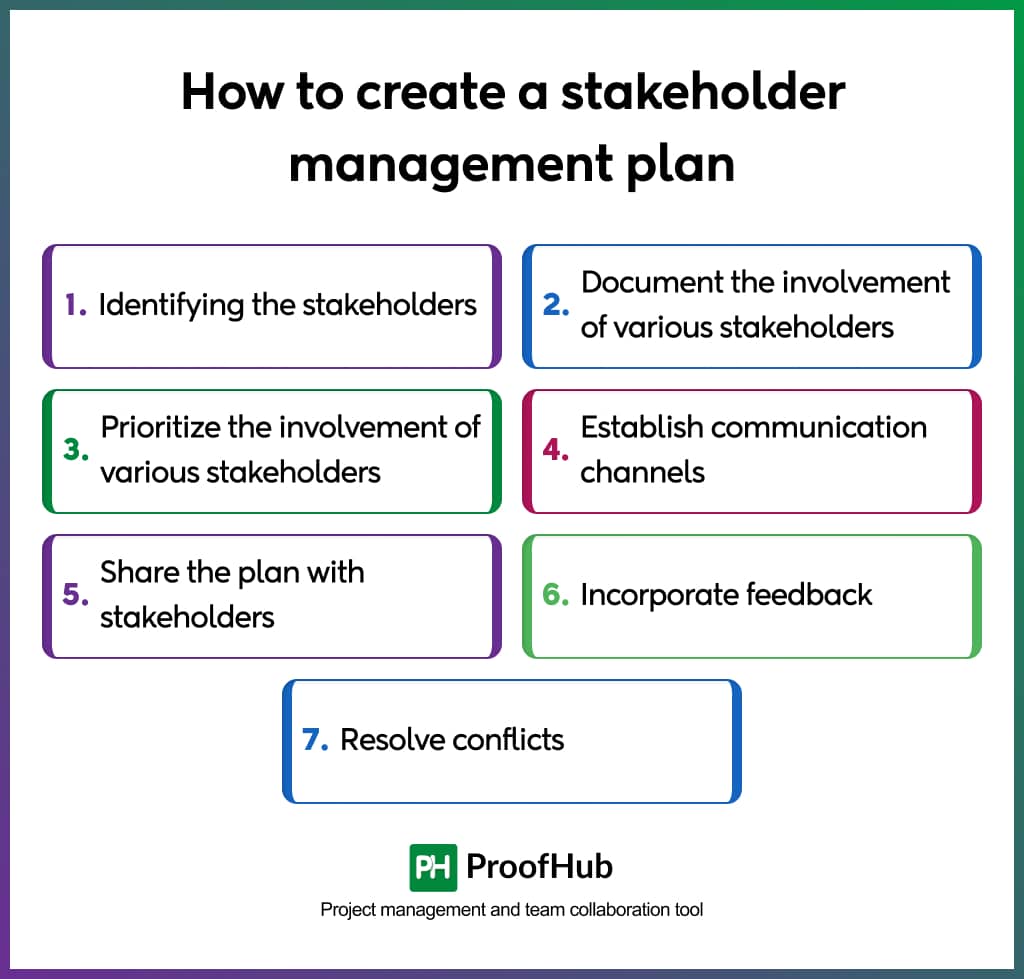
1. Identifying the stakeholders
Building a stakeholder management plan starts with identifying the stakeholders. Different projects have different stakeholders who have an interest in that particular project.
For instance, consider the list of stakeholders that I mentioned above, in a project that involves remodeling the home page of a website, the front-end designers will be involved as major stakeholders. However, if the project is about reworking the database, the backend designers will be involved as major stakeholders.
2. Document the involvement of various stakeholders
Stakeholders play a crucial role in the overall performance of the project. However, when creating a stakeholder management plan, you need to define the involvement of various stakeholders in the project. This documentation is necessary as it keeps track of the roles and responsibilities of various stakeholders.
This step should be specific to various stakeholders so you can define each stakeholder’s role in the project’s day-to-day activities. This should include general activities like daily standups, to important features like product launches and delivering working products.
3. Prioritize the involvement of various stakeholders
Categorize the involvement of various stakeholders into different categories. This could be in the form of “low”, “medium”, or “high”. This will help you, as well as the other stakeholders, to identify how much different entities are interested in the overall success of the project.
It is important to note here that the designation does not necessarily influence the level of interest of the stakeholders in the project. Prioritizing various stakeholders directly depends on the value they add to the project.
4. Establish communication channels
Communication channels play a key role in keeping various entities on the same page. When you define the channel you will use for communication, it makes the process simple by eliminating confusion and unorganized transfer of information on multiple platforms.
After deciding on the communication channel, you need to decide on the frequency of interaction, too. Documenting this step is necessary to eliminate unwanted interruptions and build a smooth platform for project completion.
5. Share the plan with stakeholders
Once you build a stakeholder management plan, it is essential to make the document easily accessible to all stakeholders. The stakeholder management plan should be easily accessible to every stakeholder involved with that particular project.
Creating a transparent platform ensures that every different entity is aware of the typical progression and performance of the project. This will ensure that no information is overlooked and everyone is on the same page.
6. Incorporate feedback
As soon as you share the stakeholder management plan with the involved stakeholders, there may be changes needed by different entities. This could be in the form of their involvement or the frequency of interaction.
You can take in feedback from the different stakeholders and make the necessary changes in the stakeholder management plan. By incorporating these changes, you can effectively fulfill the expectations of various stakeholders.
7. Resolve conflicts
Conflicts arise when multiple stakeholders are involved. This is because what is important for one entity may not hold equal importance to another. There are chances where different team members are not comfortable with the role they are assigned in the project. This is where your conflict management and resolution skills come in. Addressing and resolving conflicts early ensures that there are no significant delays in the project.
Read more: 7 Project management conflicts & ways to solve them
Common challenges in stakeholder management
The most common challenges in stakeholder management for a project include not identifying all the stakeholders, unrealistic expectations, conflicting priorities, poor communication, and power struggles. Here is the brief explanation of these challenges:
1. Misidentification of stakeholders
Not identifying all the stakeholders results in missed project requirements. New requirements by undefined stakeholders can cause delays, derail decisions, or even lead to project failure as their needs weren’t considered in the initial plan. I even posted a question in a PM community thread, “How can project managers identify and engage informal stakeholders who aren’t on official charts but can still derail projects?”
Lissette Indhira Pimentel Sosa suggests, these “shadow stakeholders” can absolutely make or break a project if overlooked. In my experience, the key is to map informal influence early through observation and listening: who people go to for advice, who quietly shapes opinions in meetings, or whose past experience carries weight. I’ve used stakeholder interviews, anonymous pulse surveys, and even hallway conversations to surface these voices. Once identified, I try to engage them through informal check-ins and trust-building, rather than only formal channels. Often, just giving them space to be heard reduces resistance and turns them into allies instead of blockers.
2. Unrealistic expectations
Stakeholders may have vague, overly optimistic, or simply incorrect expectations about the project’s scope, timeline, budget, or benefits. This is often due to miscommunication, over-promising by sponsors, or a lack of early involvement. Stakeholders might expect outcomes that exceed project limitations, leading to frustration and disappointment.
3. Conflicting interests
Projects often involve stakeholders with varying priorities. This makes it difficult to find consensus and balance competing interests.
4. Poor communication
Insufficient information, wrong channels, lack of feedback, and even information overload result in communication breakdown, which leads to misunderstandings, mistrust, and disengagement.
5. Power struggles
Power struggles are common in a project with multiple stakeholders. For example, a highly influential stakeholder might try to exert their influence outside the formal process. If not managed carefully, this can lead to poor decision-making and demoralize other stakeholders, resulting in withdrawal of buy-in and support.
Addressing these challenges involves robust stakeholder analysis, regular and transparent communication, and strategic prioritization for lasting project success.
Stakeholder management best practices
Let us explore the best practices in stakeholder management.
Having technology for assistance is the key. Project management software will help you manage stakeholders with ease. In the below steps, I have mentioned the actionable steps, how ProofHub an an all-in-one project management and team collaboration tool, can be handy in different stages of stakeholder management along the project lifecycle.
1. Define stakeholders with precision
Choose the necessary stakeholders for your project with care. When you onboard extra stakeholders, there is an influx of too many iterations. Similarly, a shortage of stakeholders will hamper the smooth progression of projects.
Defining the role and responsibilities of every stakeholder will ensure equal contribution and seamless project progression. At this stage, you need to ask two questions simultaneously:
- Does this project require additional stakeholders?
- What value does a particular stakeholder add to the project?
Both these questions will help you in defining the stakeholders precisely needed for a particular project.
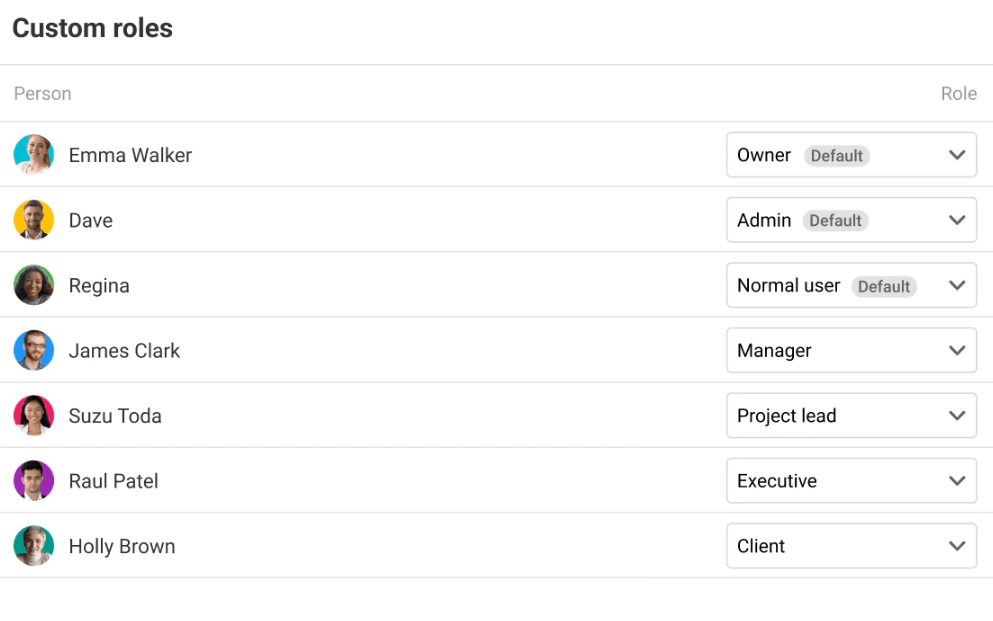
2. Involve stakeholders at the right time
Ensure that your stakeholders do not come up with suggestions and conflicts at random instances. You need to set up an effective time frame and communication channel to streamline the process.
Stakeholders coming up with the right message at the right time will enhance the overall quality of the project. This is critical for the overall smooth functioning of the project.
3. Communicate regularly and consistently
Set up a time frame and a communication channel that will help streamline the communication between the stakeholders and the management. An effective system should ensure quick and timely communication, ensuring minimum time spent in resolving conflicts and other issues. With ProofHub, you can clearly define communication channels with ease. ProofHub provides you with a built-in chat for quick communication. This further organizes communication on the platform and eliminates the need for multiple platforms and tools. This ensures that the expectations of every stakeholder are fulfilled in the project lifecycle.
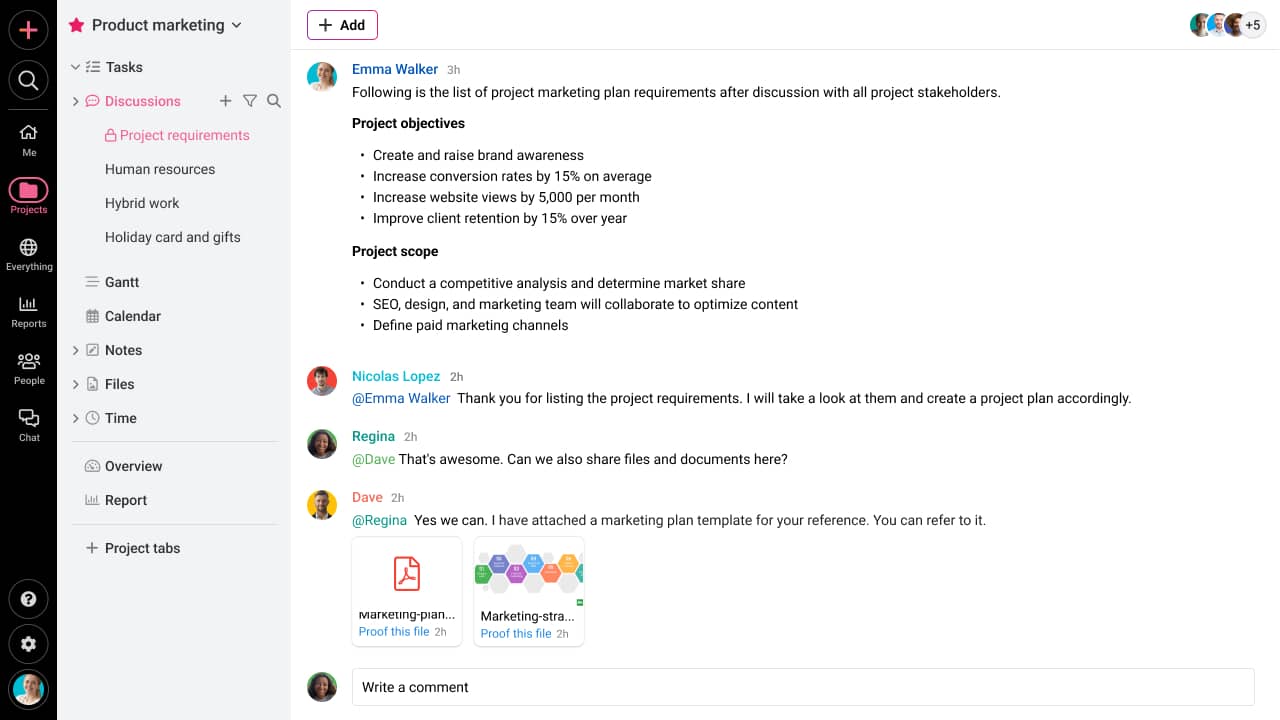
4. Establishing transparency
The stakeholder management plan and other project information should be easily comprehensible. It is advisable to differentiate stakeholders into two broad categories.
- Leadership stakeholders
- Audience stakeholders
This will help you prepare your project information and deliver it effectively.
ProofHub serves as a centralized dashboard where you can identify the role and involvement of various stakeholders in the project. Further, you can limit the access of different members. This allows access to the necessary information only.
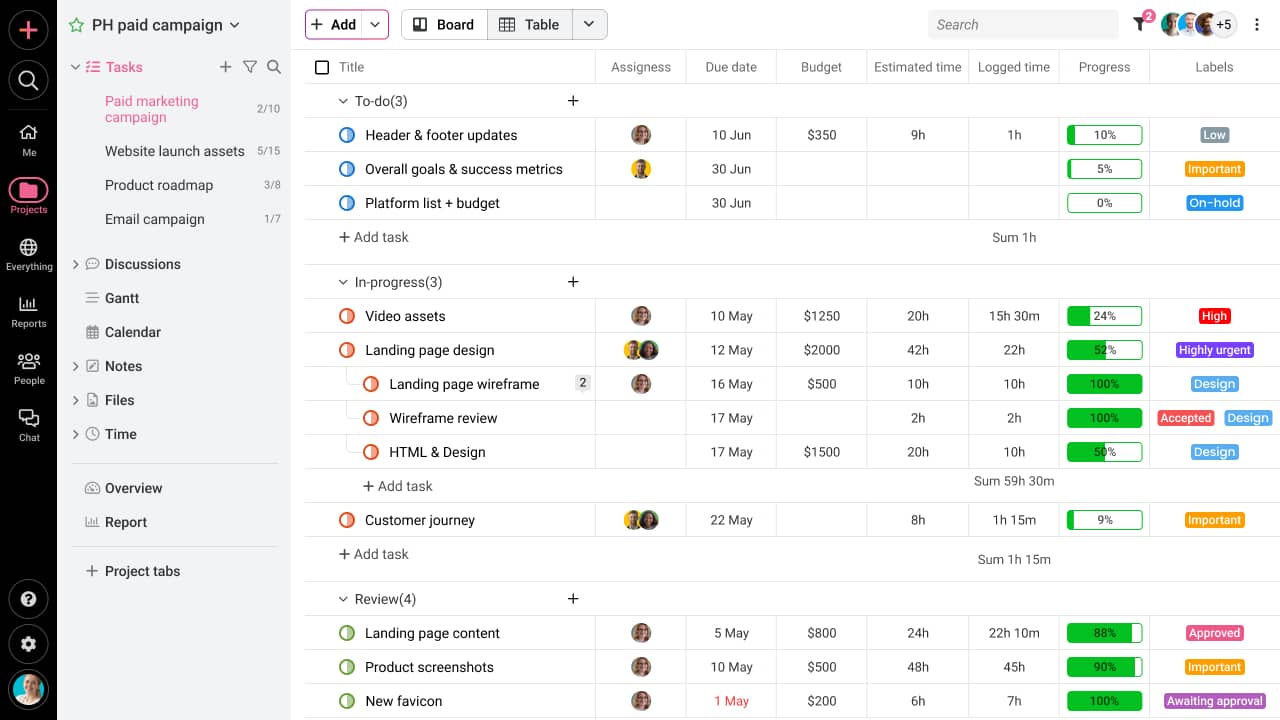
5. Encouraging a continuous feedback mechanism
Decide on a feasible time frame for planning and scheduling feedback sessions. This will prevent a random surge of suggestions, which will eventually hinder the smooth flow of the project. Setting up a timeframe for feedback will ensure that the project fulfills the expectations of all the involved stakeholders. With ProofHub, you can establish a smooth platform for back-and-forth communication and incorporate feedback as and when necessary. Further, the powerful collaboration functionalities like Discussions, Notes sharing, and comments with @mention ensure that every entity is aware of the project performance.
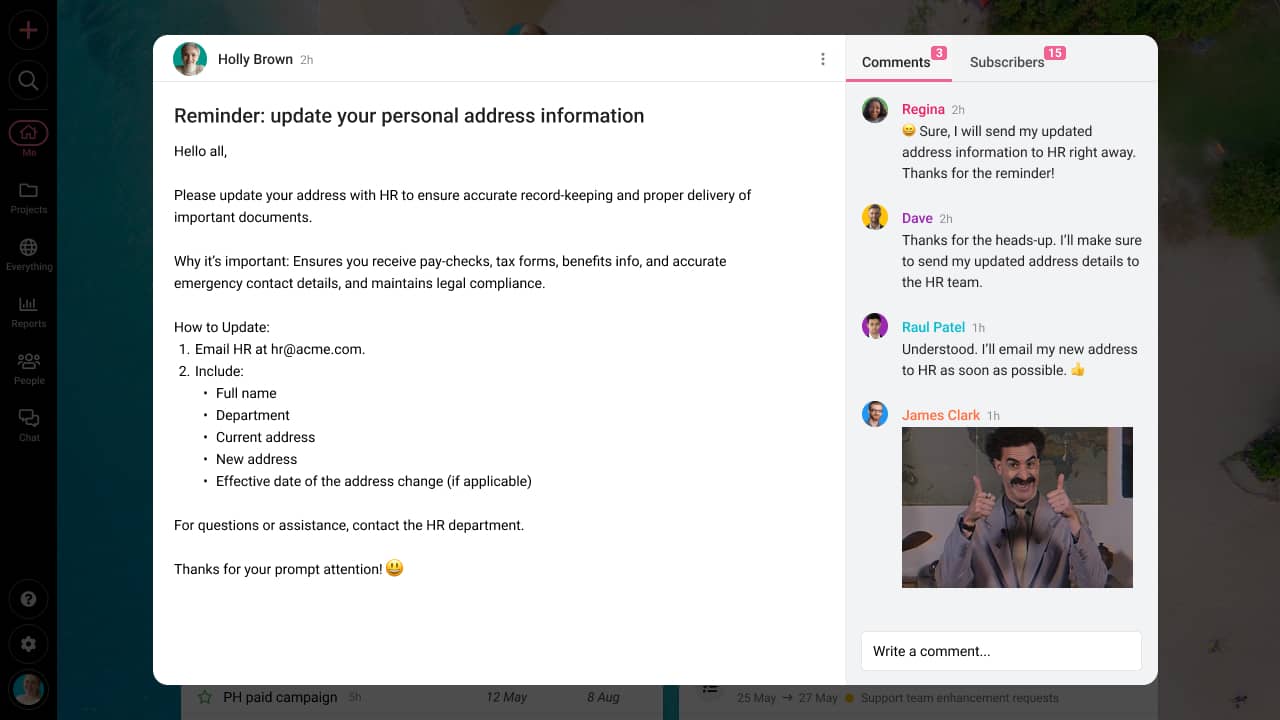
What are stakeholder management skills?
A project manager requires a diverse set of skills for effective stakeholder management in a project, such as effective communication, stakeholder analysis, relationship building, conflict resolution, and agility. Here is a brief explanation of core skills:
- Communication: Clear, concise, and active communication helps a project manager understand stakeholders’ needs, articulate the project goals, timelines, and constraints clearly to the team, and keep stakeholders informed and engaged throughout the project.
- Stakeholder analysis: A project manager should know about tools like the power-interest matrix and have strong critical thinking, analytical skills, and strategic thinking to systematically identify all stakeholders, analyze their interests, influence, expectations, and impact on the project.
- Relationship building: A manager should be able to build trust and strong relationships with stakeholders to secure support and collaboration. It includes bringing stakeholders together, fostering a collaborative environment, and facilitating transparent communication and meetings where everyone feels heard and valued.
- Conflict resolution: A manager should have strong emotional intelligence, negotiation, and problem-solving skills to address the varying priorities of the stakeholders and prevent conflicts by anticipating, addressing, and managing disagreements. Emotional intelligence is the ability to understand and manage one’s own emotions and others, also to empathize with others. Negotiation is the ability to resolve conflicts and reach agreements that benefit all parties. Problem-solving is the ability to analyze situations and implement effective solutions.
- Agility: Agility is defined as the ability to adapt based on changing circumstances or stakeholder feedback. A manager should be flexible enough to adapt and respond to feedback to ensure project success for dynamic projects.
Real-world examples of stakeholder management
Before concluding, let me quickly run you through a real-world practical example where stakeholder management comes in handy.
Let us take the example of a large IT company launching a new product. The company aims for the product to be ground-breaking and boost the overall income. The major stakeholders in this project would include the product development team, potential investors, and target customers. However, the marketing team members would count as the most important stakeholders. This is because the product development team would work on building an effective interface for enhancing the user experience. The marketing team is solely responsible for placing the product in the right market. Their research will be the turning point that decides the performance of the new product.
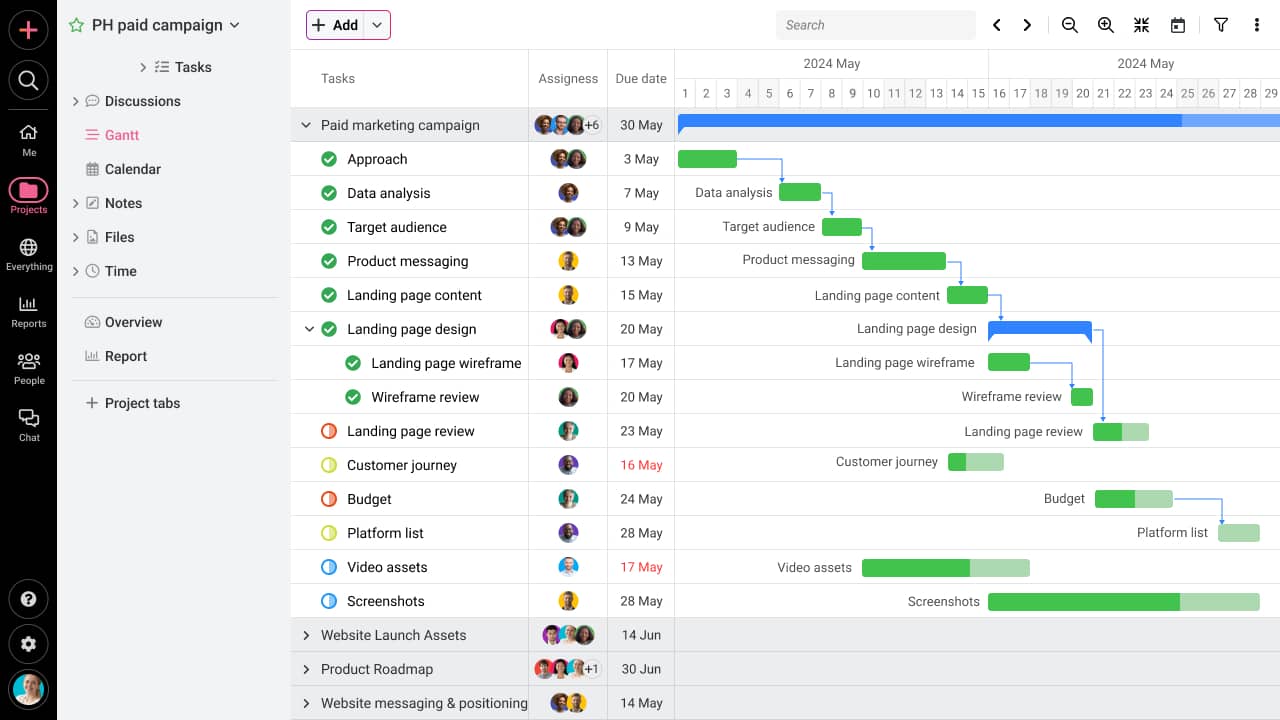
This example states the importance of choosing and laying emphasis on the right stakeholders. Different stakeholders play different roles throughout the project lifecycle. By choosing the right stakeholders, you enhance the chances of a successful outcome of the project.
How do you assess and categorize stakeholders for better management?
The Power/Interest grid is the most common technique used to assess and categorize stakeholders. It includes identifying all the stakeholders, gathering information to analyze for influence and interest, categorizing them in a 2×2 grid, and tailoring a strategy for stakeholders in each category (Manage closely, Keep satisfied, Keep informed, and Monitor).
How does stakeholder management contribute to project success?
Stakeholder management contributes to project success in the following ways:
- preventing scope creep by identifying the needs of all stakeholders
- preventing conflicts by improving alignment among stakeholders
- securing necessary resources and support
- identifying risks and planning mitigation strategies by involving stakeholders
- improving the quality of deliverables and adapting to changes by actively engaging stakeholders at a crucial time

